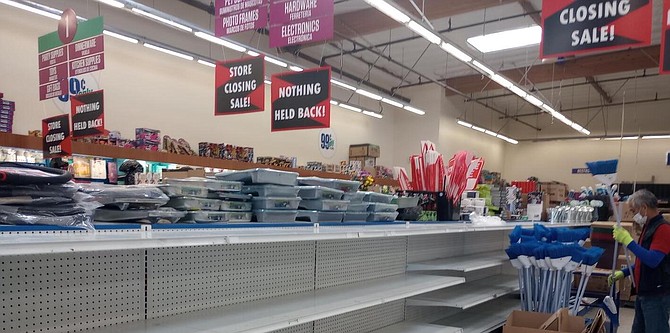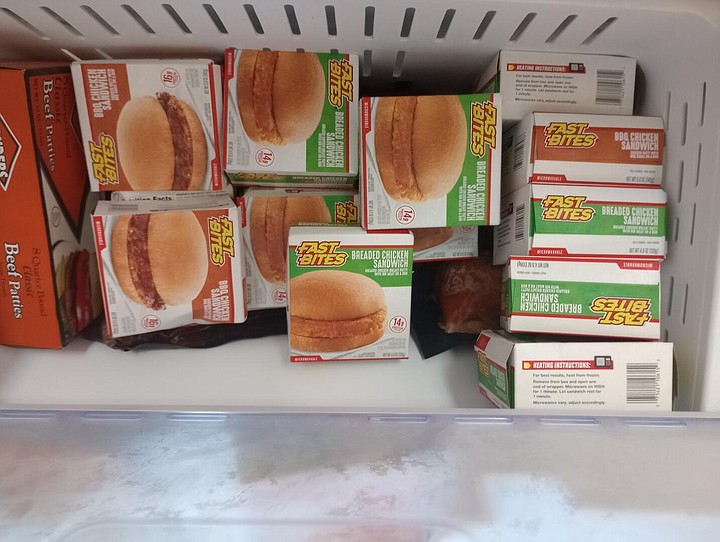 Facebook
Facebook
 X
X
 Instagram
Instagram
 TikTok
TikTok
 Youtube
Youtube

Shortly after 99 Cents Only Stores announced last week that they were closing down, hundreds of San Diegans scrambled for alternative places to bargain shop.
Charger Steve, founder and organizer of the Cajon Classic Cruise car show: "This is no joke," he said. "I do my grocery shopping there; that's the only store I shop at. I may starve to death!"

Steve found frozen ham and cheese sandwiches at the Dollar Tree, which he ate for dinner the night before our interview. "It was pretty good, and again, only $1.25 .... a lil' mayo and a pickle, and I'm set for $1.25 a day!"
Charger Steve goes by the moniker inspired by his show car, a 1969 Dodge Charger like the one used in The Dukes of Hazzard sitcom from the 1970s-1980s. At the 99 Cents Stores in town, he'd regularly purchase 99-cent Hot Wheels and Matchbox toy cars, and he scored candy and frozen pops deals for the children attending his weekly and free-of-charge Wednesday night car shows.
After the shelves at the 99 Cents Only Stores had been bare in the last few days, reality kicked in with Steve. Instead, "I went to the Dollar Tree, which made me feel better because the employee said they would not be closing. There were silly string and glow sticks for the kids."

Like Steve, other San Diegans mentioned online heading to Dollar Tree discount stores, a chain not affiliated with 99 Cents Only Stores. The most significant difference between the two bargain store giants is that 99 Cents Only Stores carried fresh produce—lettuce, tomatoes, celery, onions, mushrooms, avocados, and fruit.
"Man, Dollar Tree is the shi#," said Christopher D. "When I'm struggling, I can eat for three bucks. Yes, it's a necessity for people. I was without work for five months; that store saved my ass for sure."
Abel Moreno suggested Stater Brothers for chips, which initially cost $3.99 a bag but dropped to "$1.99 when you purchase four .... and download the Walmart app and scan as you buy. You will see price differences."

The Walmart app is free to download and use. Its scanner interface enables phones to read prices, some secretly on clearance but not in plain view.
Then there are the blowout carts and shelves at Walmarts, usually in the aisles by the eggs and milk. I've seen pastries, bread, and cereal boxes on sale for more than 50 percent off on these carts. Down the way, some packages are deeply discounted in the meat refrigerators. Last time I went, 16-ounce sausage rolls, which normally retailed for $3-$4, were 99 cents apiece. Let's not forget the seasonal items on the other side of the store; now, you can still find Easter-themed and brand-name candies and cookies for close to 99 Cents Only Stores prices.
John Suarez, a Chula Vista artist, has been a regular at 99 Cents Only Stores since it launched in 1982. He'd regularly purchases cat food and snacks. "I'm now going to GTM, Dollar Tree, Dollar General, Family Dollar, the $1.25 Store—and Grocery Outlet and Asian supermarkets to buy my produce. I wonder why 99 Cents Only Stores is closing all its stores?"
In previous mainstream reports, interim chief executive of 99 Cents Only Stores Mike Simoncic stated, "This was an extremely difficult decision and is not the outcome we expected or hoped to achieve." He mentioned that the reasons for shutting down the discount stores were aftereffects of Covid, changes in what consumers want, inflation, product loss due to shoplifting, internal theft, and admin errors.
According to a recent press release, the parent company that owns 99 Cents Only Stores, Holdings, Inc. filed for Chapter 11 last week and is selling its buildings and assets to recoup as much money as possible. There are 371 stores throughout California, Arizona, Texas, and Nevada slated to close down, and reportedly 17,000 employees.
Charger Steve concluded, "It's pretty tough to pay bills when you're selling s#it for a buck these days. I feel the same way as when Blockbuster closed."


Shortly after 99 Cents Only Stores announced last week that they were closing down, hundreds of San Diegans scrambled for alternative places to bargain shop.
Charger Steve, founder and organizer of the Cajon Classic Cruise car show: "This is no joke," he said. "I do my grocery shopping there; that's the only store I shop at. I may starve to death!"

Steve found frozen ham and cheese sandwiches at the Dollar Tree, which he ate for dinner the night before our interview. "It was pretty good, and again, only $1.25 .... a lil' mayo and a pickle, and I'm set for $1.25 a day!"
Charger Steve goes by the moniker inspired by his show car, a 1969 Dodge Charger like the one used in The Dukes of Hazzard sitcom from the 1970s-1980s. At the 99 Cents Stores in town, he'd regularly purchase 99-cent Hot Wheels and Matchbox toy cars, and he scored candy and frozen pops deals for the children attending his weekly and free-of-charge Wednesday night car shows.
After the shelves at the 99 Cents Only Stores had been bare in the last few days, reality kicked in with Steve. Instead, "I went to the Dollar Tree, which made me feel better because the employee said they would not be closing. There were silly string and glow sticks for the kids."

Like Steve, other San Diegans mentioned online heading to Dollar Tree discount stores, a chain not affiliated with 99 Cents Only Stores. The most significant difference between the two bargain store giants is that 99 Cents Only Stores carried fresh produce—lettuce, tomatoes, celery, onions, mushrooms, avocados, and fruit.
"Man, Dollar Tree is the shi#," said Christopher D. "When I'm struggling, I can eat for three bucks. Yes, it's a necessity for people. I was without work for five months; that store saved my ass for sure."
Abel Moreno suggested Stater Brothers for chips, which initially cost $3.99 a bag but dropped to "$1.99 when you purchase four .... and download the Walmart app and scan as you buy. You will see price differences."

The Walmart app is free to download and use. Its scanner interface enables phones to read prices, some secretly on clearance but not in plain view.
Then there are the blowout carts and shelves at Walmarts, usually in the aisles by the eggs and milk. I've seen pastries, bread, and cereal boxes on sale for more than 50 percent off on these carts. Down the way, some packages are deeply discounted in the meat refrigerators. Last time I went, 16-ounce sausage rolls, which normally retailed for $3-$4, were 99 cents apiece. Let's not forget the seasonal items on the other side of the store; now, you can still find Easter-themed and brand-name candies and cookies for close to 99 Cents Only Stores prices.
John Suarez, a Chula Vista artist, has been a regular at 99 Cents Only Stores since it launched in 1982. He'd regularly purchases cat food and snacks. "I'm now going to GTM, Dollar Tree, Dollar General, Family Dollar, the $1.25 Store—and Grocery Outlet and Asian supermarkets to buy my produce. I wonder why 99 Cents Only Stores is closing all its stores?"
In previous mainstream reports, interim chief executive of 99 Cents Only Stores Mike Simoncic stated, "This was an extremely difficult decision and is not the outcome we expected or hoped to achieve." He mentioned that the reasons for shutting down the discount stores were aftereffects of Covid, changes in what consumers want, inflation, product loss due to shoplifting, internal theft, and admin errors.
According to a recent press release, the parent company that owns 99 Cents Only Stores, Holdings, Inc. filed for Chapter 11 last week and is selling its buildings and assets to recoup as much money as possible. There are 371 stores throughout California, Arizona, Texas, and Nevada slated to close down, and reportedly 17,000 employees.
Charger Steve concluded, "It's pretty tough to pay bills when you're selling s#it for a buck these days. I feel the same way as when Blockbuster closed."
Comments